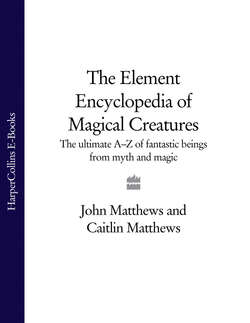Читать книгу The Element Encyclopedia of Magical Creatures: The Ultimate A–Z of Fantastic Beings from Myth and Magic - John Matthews - Страница 6
Introduction The Zoology of the Imagination
Оглавление‘The zoology of our dreams is far poorer than the zoology of the Maker.’
Jorge Luis Borges,
The Book of Imaginary Beings.
Here are creatures of every possible kind. Creatures that hold up the world; creatures that destroy the world; creatures who are one half human, one half animal and sometimes even part god. Here are animals we think we know, but whose natures are magical; creatures who have strange characteristics such as faces in the middle of their bodies, animal heads, forelegs and back legs of different species. Here also are creatures that follow us, padding silently through the night; creatures that prey upon us, from the fearsome and terrible fire-breathing dragon, to the body of water that has a mind of its own and will leap up and chase you before gobbling you up. All are the product – in one form or another – of human imagination, from a time before thought was organized into word and word into text.
Curiously, it seems we have come full circle, since in our own time imagination responds more to visual stimuli rather than to ancient tales, and we are by no means bereft of creatures that enthral, scare and astonish us with their wonder. Film and TV are, for many of us, the first and most immediate source of myth and folktale – from the classic stop-frame animation of Ray Harryhausen, who gave us Medusa and Pegasus in Jason and the Argonauts, to Steven Spielberg’s Jurassic Park, with its credible dinosaurs, we have gained an appetite for ever more wondrous creatures. Whether we think of the computer-animated adventures of the ogre Shrek, or the mythic creatures conjured up, and sometimes ridden, by Harry Potter and his friends at Hogwarts Academy, we are not content simply to accommodate the creatures we have known from the past – we want more. The cinema has not been slow to satisfy this appetite and to stretch our imagination even further. George Lucas has given us a veritable menagerie of new species in his Star Wars universe – from Wookies to Bantha, from Rancor to Hutt. In addition, a legion of movies and TV shows such as Buffy the Vampire Slayer, Angel and Ultraviolet, numerous versions of Dracula and the Blade trilogy, have kept the history of Vampires and Werewolves fresh and alive in our dreams. These clearly demonstrate that we have not seen the last of the creatures that are to enter into creation.
The naming of animals is a primal task, one that God, in the Christian myth, gave to Adam in the Garden of Eden. Naming is a means of understanding more about an animal, for the name denotes the nature. Our collection is a wonderful menagerie where names have been arranged in alphabetical order for ease of consultation, but we urge you to read where your imagination prompts you, as it pleases you to explore, to learn more about Kkuuxuginaagits, the Ganiagwaidhegowa or the wonderfully onomatopoeic Toatoatavaya-o.
This book is a zoology of the imagination more than it is a natural history. It follows the myths of magical creatures wherever they show themselves, myths that are primal stories encoding understandings that we grasp by means of metaphor rather than with any literal-mindedness. Where will these creatures lead us?
